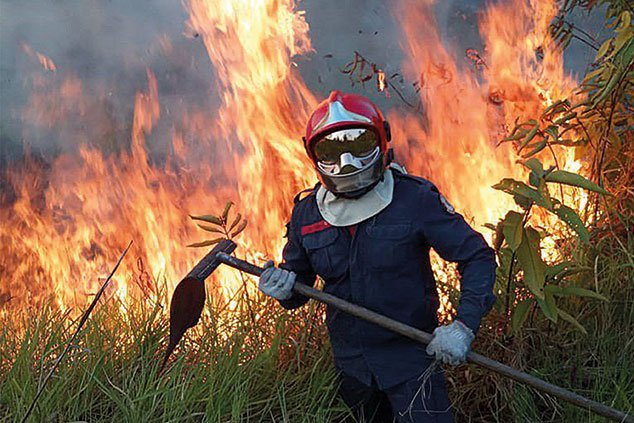
What has happened?
G7 leaders this week agreed an £18m aid package plus logistical support to help Brazil fight fires in the Amazon rainforest. The offer was rejected by Brazilian president Jair Bolsonaro, who has accused the group of a “colonialist” mentality. Facing growing international pressure, his government has instead opted to deploy 44,000 troops to combat the blazes. Brazil’s space agency says there has been an 85% rise in Amazon fires compared with this time last year.
What is on fire?
Dramatic images of “an entire forest ablaze”, which have been widely shared on social media, are misleading, says Jonathan Watts in The Guardian. Most fires were set by farmers on agricultural land in already deforested areas. The increase in fires between August and October every year coincides with the season when farmers begin planting soybean and corn, says The New York Times. Yet this year the fires are particularly widespread. The Global Fire Emissions Database reports that the Amazon’s 2019 fire season has been the worst since at least 2012. Moreover, the intensity of the fires suggests more virgin forest than usual is being incinerated.
Who is to blame?
Many observers point the finger at Bolsonaro, who took office in January. He draws significant support from the country’s farmers and is a strong proponent of opening up the vast Amazonian interior for development. His rhetoric appears to have led illegal loggers to conclude that they have little to fear from federal authorities. Yet the problems run deeper than one man. Deforestation in Brazil has been ticking up over the past five years. Bolsonaro’s predecessor, Michel Temer, slashed 44% from the federal science budget, notes Zoe Sullivan in Time magazine, hamstringing the environment agency’s efforts to police illegal logging and mining. This summer has also brought severe fires in neighbouring Bolivia, where left-wing leader Evo Morales has been doling out free land to peasants.
Has this happened before?
Yes. During the 1990s and 2000s as much as 10,000 square miles of the Brazilian Amazon was cut down every year. Concerted international pressure and better policing saw rates of deforestation fall 80% by 2014. The worry now, as environmental scientist Jonathan Foley tells Science News, is that these fires mark a “major backslide into the bad old days”. Continuous deforestation reduces local rainfall, potentially driving the region to a “tipping point” where the Amazon could flip suddenly from being a rainforest to something closer to an arid savannah. Brazil would be the biggest loser from that as droughts would ruin local agriculture.
Shouldn’t Brazilians get to decide?
Bolsonaro smells Western hypocrisy. “We preserve more [rainforest] than anyone. No country in the world has the moral right to talk about the Amazon. You destroyed your own ecosystems,” he told journalists last month. In economic terms, this is known as a “positive externality” – the world is essentially asking Brazil to forego the development potential of the rainforest so that wecan all breathe more easily. The solution is to make preservation pay. Britain is currently funding a £30m reforestation initiative in Brazil. Yet the Bolsonaro government’s lack of commitment to the conservation efforts has prompted some countries – notably Germany and Norway – to conclude that payments to Brasília are being wasted and to cut back funding this month.
What about trade?
The EU and South American trading bloc Mercosur are currently wrapping up a massive trade deal, but the Amazon fires have emboldened greens who say the accord will stoke more deforestation. A larger market for Brazilian beef will only increase the incentives for farmers to slash and burn, says Bard Harstad in the Financial Times. Yet trade deals can also be a “carrot and stick” for conservation efforts. France and Ireland have both threatened to veto the deal unless Brazil improves protection efforts in the Amazon. That may persuade Brazil’s pro-business government, and major exporters, that conservation is a matter of national interest. Twenty percent of Mercosur’s exports already go to Europe, making it the second most important market for the region’s producers.
How else can we protect the Amazon?
Property rights. The Brazilian constitution guarantees land rights for indigenous peoples, which can act as a buffer against the loggers and miners moving in. “When indigenous land rights are secured via titles – official documentation from the state – we see significantly lower deforestation rates within just two to three years,” Peter Veit of the World Resources Institute think tank tells the American edition of The Week. Yet the Bolsonaro government has stalled recognition of such land claims and, with law-enforcement budgets in remote regions being slashed, there are more opportunities for encroachment and outright theft to occur.
Why does it matter?
The assertion (most recently made by the French president, Emmanuel Macron) that the Amazon is “the lungs of the Earth” is incorrect – in effect it consumes as much oxygen as it produces. However, about 25% of Western drugs are thought to depend upon its rich biodiversity, and its 400 billion trees play a key role in sequestering carbon, reducing the pace of climate change. The destruction of rainforests accounts for “up to 20% of all carbon emissions”, says Johan Eliasch in The Daily Telegraph. Protecting the trees is the “cheapest way of reducing carbon emissions”, yet rainforests receive a fraction of the government support given to clean-energy initiatives. “We will never save the rainforest until a living tree is worth more to Brazil than an incinerated one.”